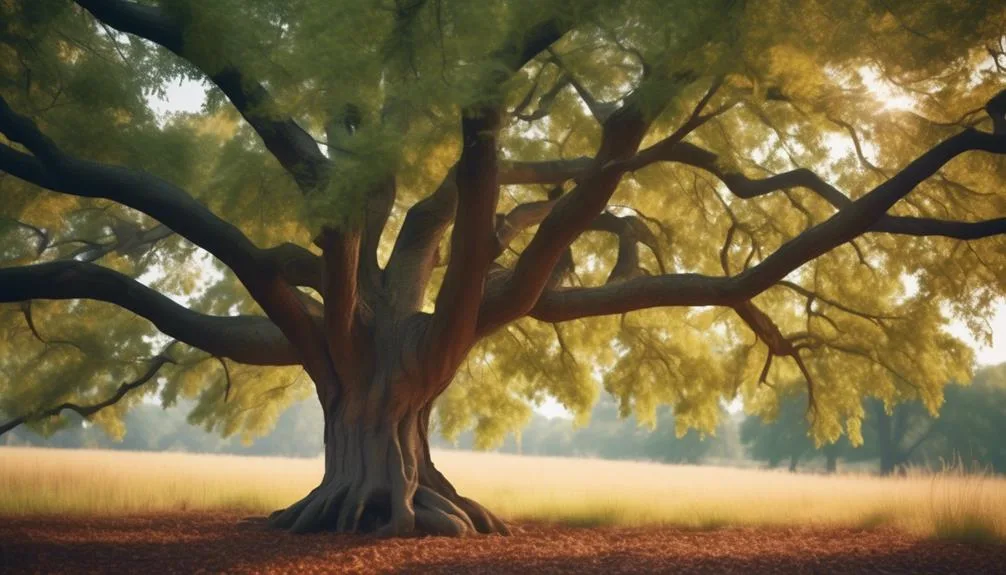As climate patterns shift, hickory trees face a crucial question: can they adapt?
Their ability to withstand the changing environment depends on a mix of biological factors and environmental challenges.
Exploring the world of these resilient trees reveals a compelling story of survival and the obstacles they confront.
Hickory Trees and Climate Change
How are hickory trees being affected by climate change, and what're the implications for their future survival and distribution?
Hickory tree resilience is being tested as climate change impacts their natural habitats. These resilient trees are facing challenges such as shifting temperature patterns, changing precipitation levels, and an increase in extreme weather events. These changes can disrupt the delicate balance that hickory trees rely on for their growth and reproduction.
As a result, their future survival and distribution are at risk. The ability of hickory trees to adapt to these changes will determine their future existence. Understanding the specific impacts of climate change on hickory trees is crucial for conservation efforts and for developing strategies to ensure their continued presence in our ecosystems.
Factors Affecting Hickory Tree Adaptation
As climate change continues to impact hickory trees' natural habitats, it's important to understand the factors that influence their adaptation to these changing environmental conditions.
Factors affecting hickory tree adaptation include:
- Genetic Diversity: Hickory trees with greater genetic diversity are more likely to possess traits that enable them to adapt to environmental stressors such as changes in temperature and precipitation. This diversity allows some trees to better withstand new challenges presented by climate change.
- Environmental Stressors: The intensity and frequency of environmental stressors, such as drought, extreme temperatures, and pests, play a significant role in hickory tree adaptation. Trees must adapt to these stressors to survive and thrive in changing environments.
- Ecosystem Interactions: The interactions between hickory trees and other species in their ecosystem also influence their ability to adapt to climate change. These relationships can either support or hinder their adaptation efforts.
Adaptive Traits of Hickory Trees
Developing adaptive traits is crucial for hickory trees to thrive in the face of changing environmental conditions caused by climate change.
Genetic diversity plays a key role in enabling hickory trees to adapt to new challenges. It allows for a wider range of traits within the species, increasing the likelihood that some individuals will possess characteristics that are advantageous in the face of changing environmental conditions.
Additionally, hickory trees have the ability to occupy a specific ecological niche, meaning they can thrive in a particular set of environmental conditions and utilize available resources in unique ways. This niche adaptation allows hickory trees to maintain their presence even as the surrounding environment shifts.
Challenges for Hickory Trees in a Changing Climate
Facing the reality of a changing climate, hickory trees encounter a multitude of challenges that threaten their survival and long-term health. These challenges include:
- Genetic diversity: As the climate changes, hickory trees need to adapt to new environmental conditions. Limited genetic diversity can hinder their ability to evolve and withstand new threats, such as pests and diseases.
- Soil moisture: Changes in precipitation patterns and rising temperatures can significantly impact soil moisture levels. Hickory trees rely on consistent access to water, and fluctuations in soil moisture can lead to drought stress, affecting their growth and overall health.
- Extreme weather events: Increasingly frequent and severe weather events, such as storms and heatwaves, pose a threat to hickory trees. These events can cause physical damage to the trees and disrupt their growth cycles, making them more vulnerable to other stressors.
As hickory trees face these challenges, it becomes crucial to understand and address the potential impacts of climate change on their long-term viability.
Strategies for Supporting Hickory Tree Adaptation
To assist hickory trees in adapting to the challenges posed by a changing climate, implementing supportive strategies is essential for their long-term resilience and survival. Two key strategies for supporting hickory tree adaptation are through genetic diversity and assisted migration.
| Strategies for Supporting Hickory Tree Adaptation |
|---|
| Genetic Diversity |
| Introducing and preserving genetic diversity within hickory tree populations can enhance their ability to adapt to changing environmental conditions. By maintaining a wide range of genetic traits, hickory trees are more likely to have individuals with characteristics suited to new climate patterns. |
| Assisted Migration |
| Assisted migration involves strategically moving hickory tree populations to areas where climate conditions are more favorable. This proactive approach can help hickory trees establish in new suitable habitats and mitigate the challenges posed by climate change. |
Conclusion
Hickory trees possess adaptive traits and genetic diversity that offer a chance for them to withstand climate change. Their resilience will depend on supported conservation efforts. Understanding and addressing the factors influencing their adaptation is crucial for ensuring their survival in a changing climate.
How we assist hickory trees in this endeavor will shape their resilience for the future.

My interest in trees started when I first saw the giant sequoias in Yosemite.
I was a teenager then, and I remember thinking, “I need to learn more about this.”
That moment stuck with me.
A few years later, I went on to study forestry at Michigan Tech.
Since graduating, I’ve worked in a mix of hands-on tree care and community education.
I’ve spent over ten years helping people understand how to plant, maintain, and protect the trees in their neighborhoods.
I don’t see trees as just part of the landscape.
They are living things that make a real difference in our daily lives.
